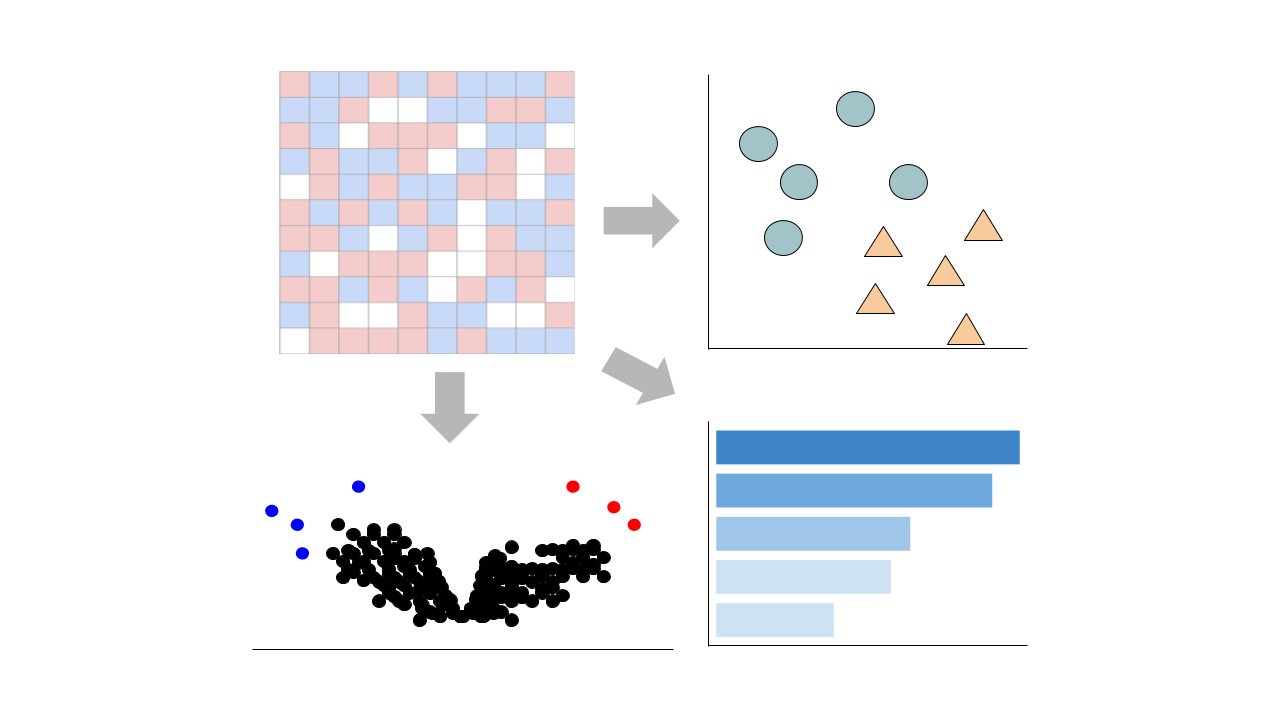 Gene counts are sourced from ARCHS4, which provides uniform alignment of GEO samples.
You can learn more about ARCHS4 and its pipeline here.
Gene counts are sourced from ARCHS4, which provides uniform alignment of GEO samples.
You can learn more about ARCHS4 and its pipeline here.
Select conditions below to toggle them from the plot:
| GROUP | CONDITION | SAMPLES |
|---|---|---|
| Pancreatic beta cells |
GSM6733379 GSM6733380
|
|
|
GSM6733383 GSM6733384 GSM6733385
|
||
|
GSM6733381 GSM6733382
|
Submission Date: Nov 15, 2022
Summary: Type 2 diabetes (T2D) is associated with defective insulin secretion, reduced β-cell mass, and β-cell dedifferentiation. Aldehyde dehydrogenase 1 isoform A3 (ALHD1A3) serves as a marker of β-cell dedifferentiation and correlates with T2D progression. ALDH1A3-positive β-cells (A+) demonstrate impaired insulin secretion, and their numbers decrease when diabetic mice are rendered euglycemic by pair-feeding. It is unknown whether ALDH1A3 activity contributes to β-cell failure, and whether the decrease of A+ cells under pair-feeding is due to β-cell restoration. To tackle these questions, we (i) investigated the fate of A+ cells during pair-feeding by lineage-tracing, (ii) somatically ablated ALDH1A3 in diabetic β-cells, and (iii) used a novel selective ALDH1A3 inhibitor to treat diabetes. Lineage tracing and functional characterization show that A+ cells can be reconverted to functional, mature β-cells. Genetic or pharmacological inhibition of ALDH1A3 in diabetic mice lowers glycemia and increases insulin secretion. Molecular interrogation of β-cells following ALDH1A3 inhibition show a reactivation of differentiation as well as regeneration pathways through the REG gene family. We conclude that ALDH1A3 inhibition offers a therapeutic strategy for β-cell dysfunction in diabetes.
GEO Accession ID: GSE218047
PMID: 36732513
Submission Date: Nov 15, 2022
Summary: Type 2 diabetes (T2D) is associated with defective insulin secretion, reduced β-cell mass, and β-cell dedifferentiation. Aldehyde dehydrogenase 1 isoform A3 (ALHD1A3) serves as a marker of β-cell dedifferentiation and correlates with T2D progression. ALDH1A3-positive β-cells (A+) demonstrate impaired insulin secretion, and their numbers decrease when diabetic mice are rendered euglycemic by pair-feeding. It is unknown whether ALDH1A3 activity contributes to β-cell failure, and whether the decrease of A+ cells under pair-feeding is due to β-cell restoration. To tackle these questions, we (i) investigated the fate of A+ cells during pair-feeding by lineage-tracing, (ii) somatically ablated ALDH1A3 in diabetic β-cells, and (iii) used a novel selective ALDH1A3 inhibitor to treat diabetes. Lineage tracing and functional characterization show that A+ cells can be reconverted to functional, mature β-cells. Genetic or pharmacological inhibition of ALDH1A3 in diabetic mice lowers glycemia and increases insulin secretion. Molecular interrogation of β-cells following ALDH1A3 inhibition show a reactivation of differentiation as well as regeneration pathways through the REG gene family. We conclude that ALDH1A3 inhibition offers a therapeutic strategy for β-cell dysfunction in diabetes.
GEO Accession ID: GSE218047
PMID: 36732513
Visualize Samples
 Visualizations are precomputed using the Python package scanpy on the top 5000 most variable genes.
Visualizations are precomputed using the Python package scanpy on the top 5000 most variable genes.
Precomputed Differential Gene Expression
 Differential expression signatures are automatically computed using the limma R package.
More options for differential expression are available to compute below.
Differential expression signatures are automatically computed using the limma R package.
More options for differential expression are available to compute below.
Signatures:
Select conditions:
Control Condition
Perturbation Condition
Only conditions with at least 1 replicate are available to select
 Differential expression signatures can be computed using DESeq2 or characteristic direction.
Differential expression signatures can be computed using DESeq2 or characteristic direction.
This pipeline enables you to analyze and visualize your bulk RNA sequencing datasets with an array of downstream analysis and visualization tools. The pipeline includes: PCA analysis, Clustergrammer interactive heatmap, library size analysis, differential gene expression analysis, enrichment analysis, and L1000 small molecule search.

 Chatbot
Chatbot Single Gene Queries
Single Gene Queries
 Gene Set Queries
Gene Set Queries
 Bulk Studies
Bulk Studies
 Single Cell Studies
Single Cell Studies
 Hypotheses
Hypotheses
 Resources
Resources
 Contribute
Contribute
 Downloads
Downloads About
About
 Help
Help